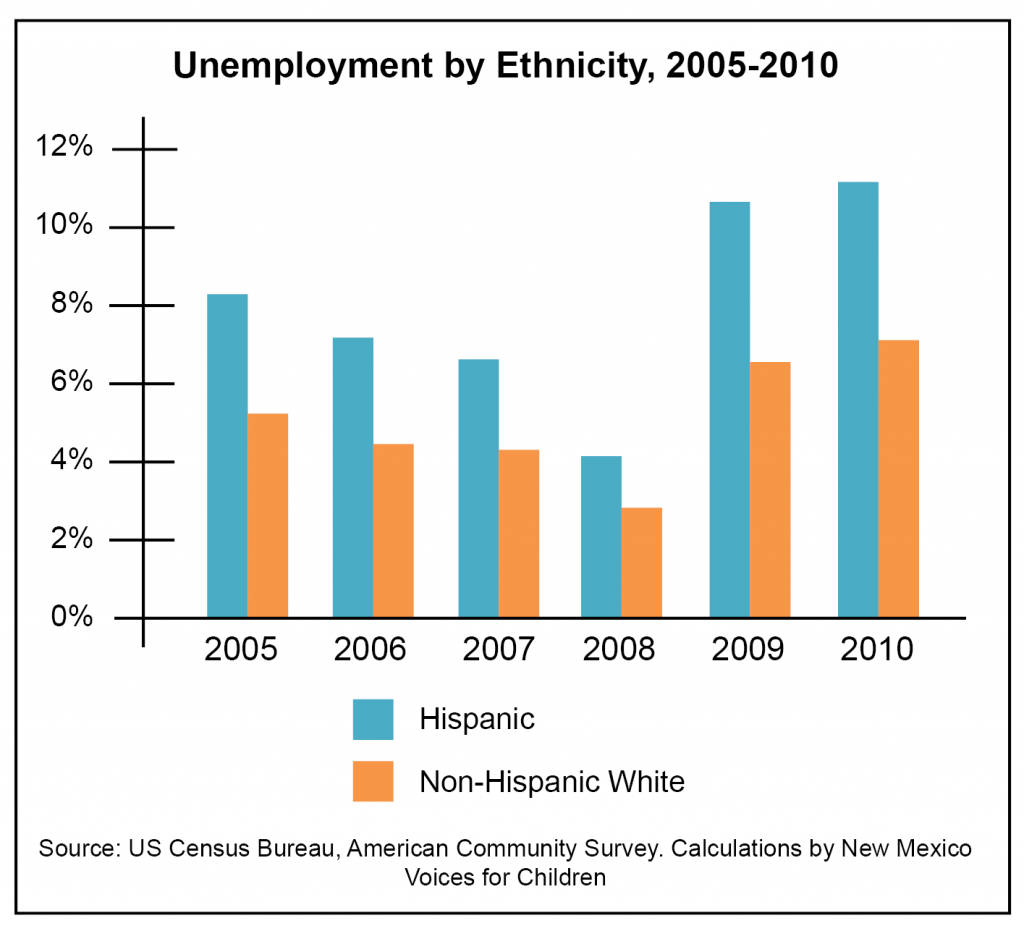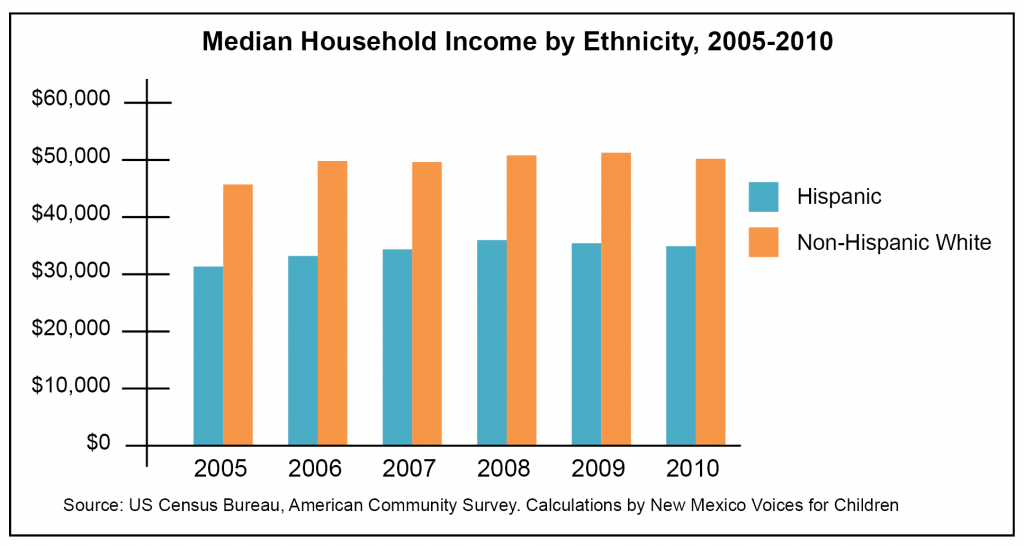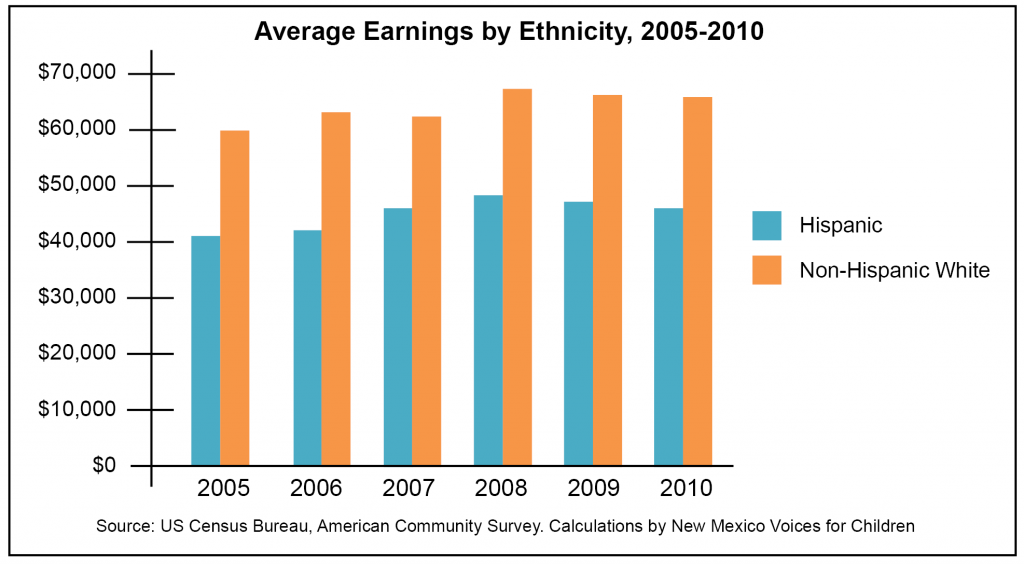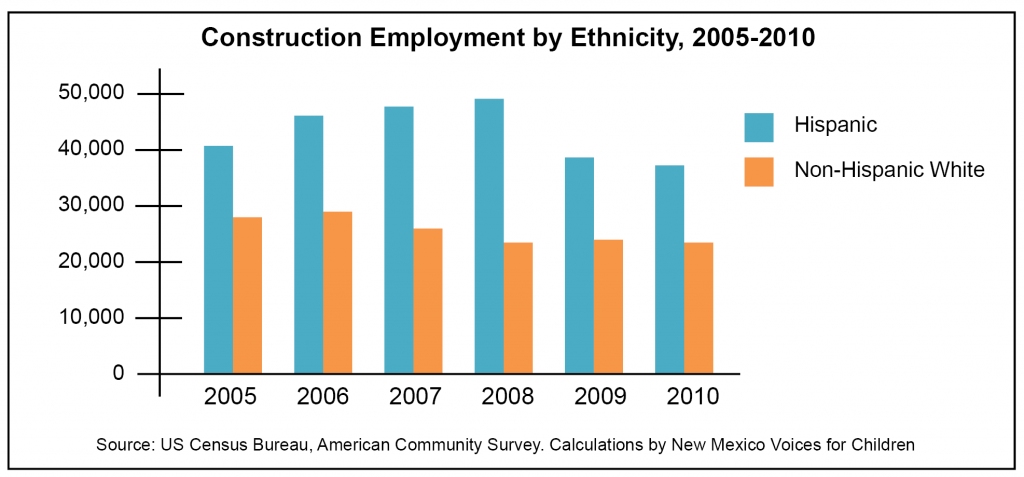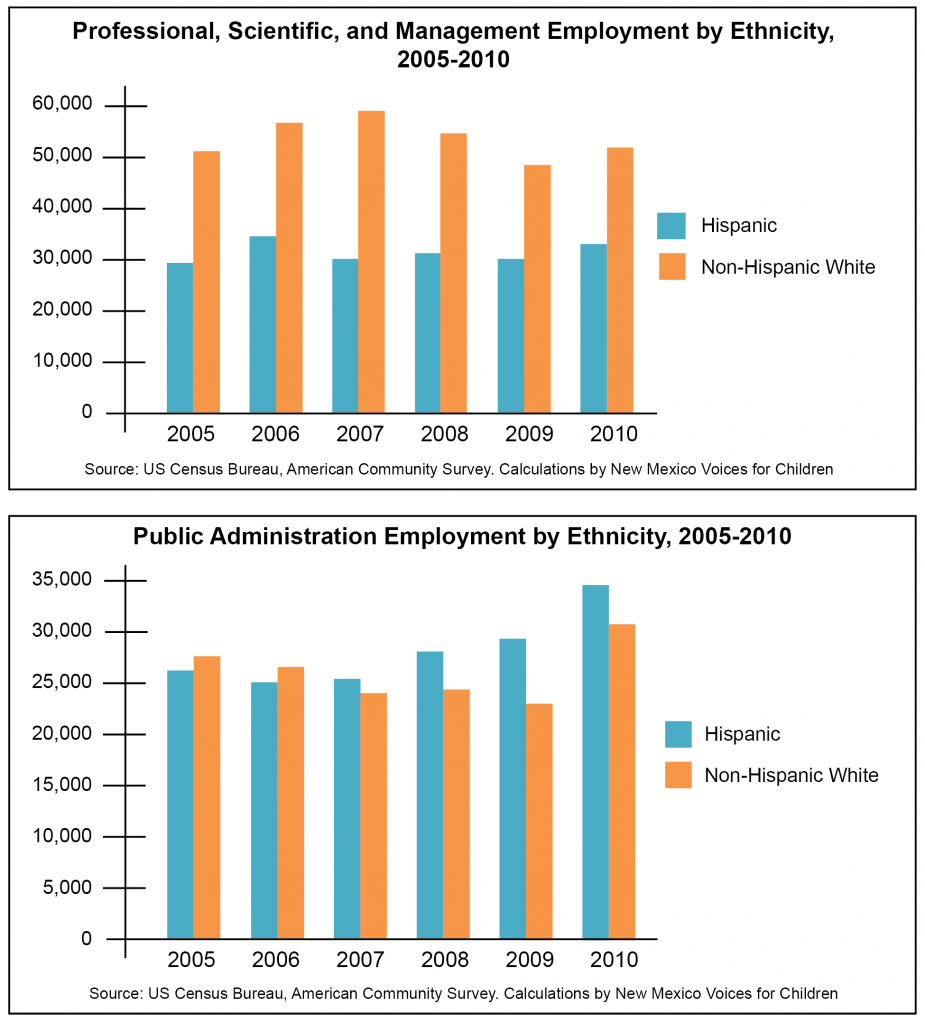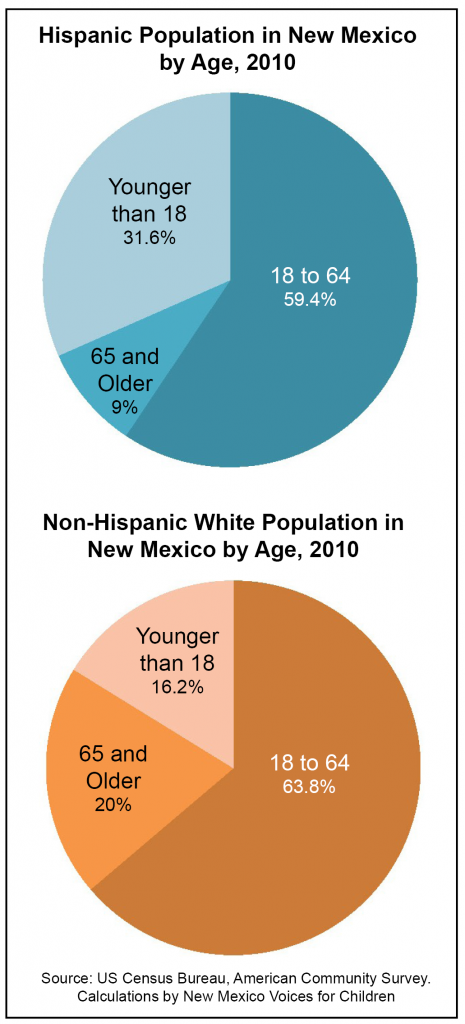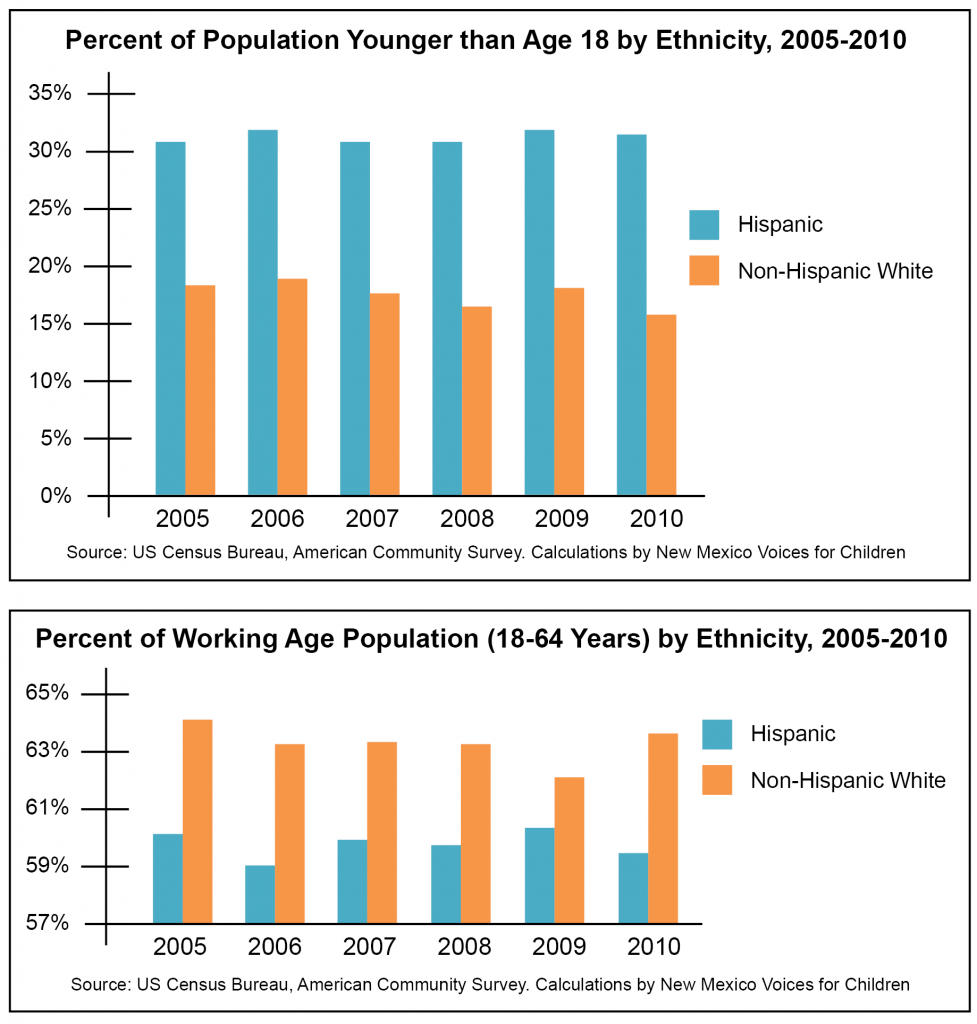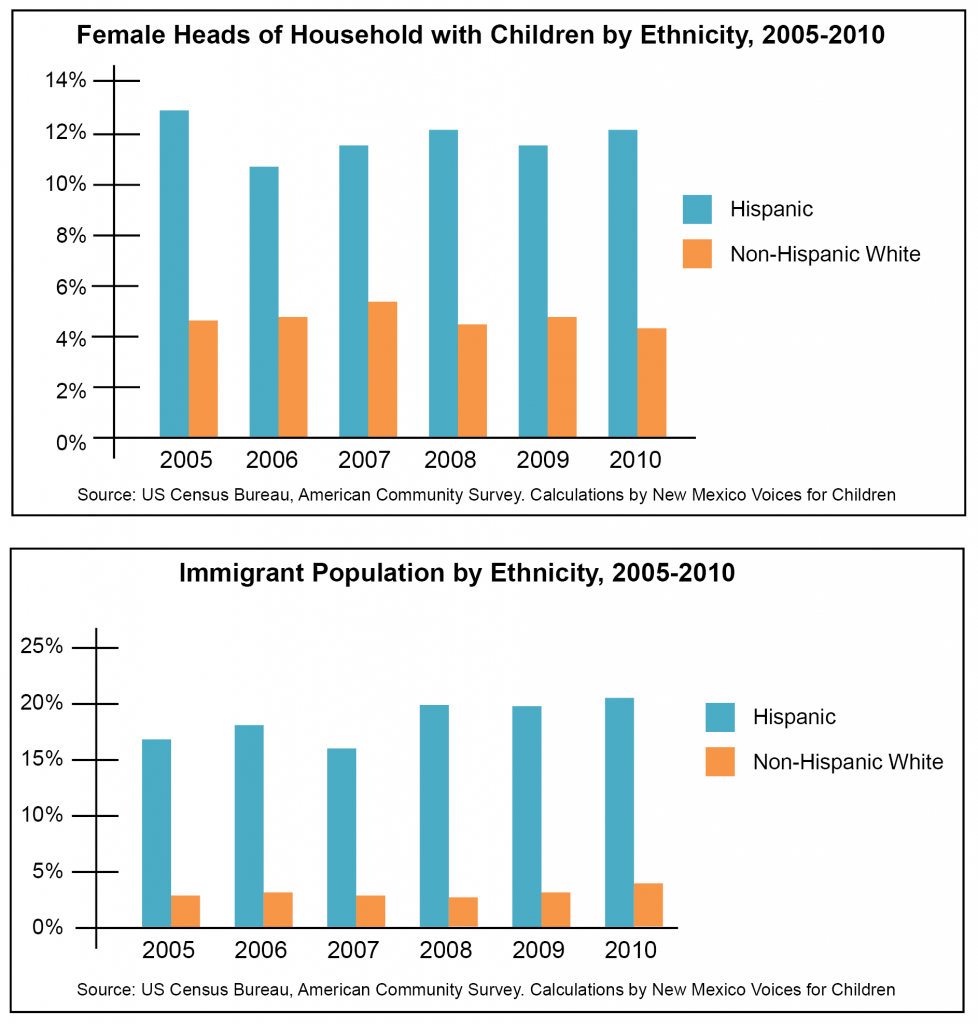Download this report (Sept. 2012; 8 pages; pdf)
The business cycle can and does have different impacts on different population groups. This has been especially evident during the Great Recession in New Mexico, with Hispanics suffering proportionately more in the downturn than non-Hispanic whites. Unemployment rates are generally higher for minority groups than for whites, and incomes and earnings are generally lower. But the pre-recession housing bubble nearly closed the gap between Hispanic and non-Hispanic white unemployment, and decreased the gaps in income and earnings. All of these gains for Hispanics were lost in the Great Recession. This paper explores why this happened.
Unemployment
Between 2005 and 2008—when the housing bubble was expanding—New Mexico’s Hispanics and non-Hispanic whites both benefitted from the growing economy. Unemployment fell by half for both Hispanics (from 8.3 percent to 4.1 percent) and non-Hispanic whites (5.3 percent to 2.8 percent) to extremely low levels. During these last three years of the housing bubble, the gap between Hispanic and non-Hispanic white unemployment rates narrowed from 3 percentage points in 2005 to 1.3 percentage points in 2008. The state economy was supercharged by the housing bubble, with a booming construction sector and rising housing prices.
While the employment situation was very favorable, the housing trajectory was not sustainable and eventually the bubble burst. By 2010, Hispanic unemployment had risen to 11.3 percent, while non-Hispanic white unemployment had risen to 7.2 percent. Both increases were drastic —Hispanic unemployment nearly tripled while non-Hispanic white unemployment more than doubled for a gap of 4.1 percentage points. The earlier progress toward narrowing the gap between Hispanics and non-Hispanic whites in the labor market was reversed.
Income and Earnings
As unemployment fell dramatically between 2005 and 2008, median household income rose for both Hispanics and non-Hispanic whites, but Hispanics benefitted more. Hispanic household income in 2005 was about $32,000 while non-Hispanic white household income was $46,500. This put Hispanic household income at about 70 percent of non-Hispanic white household income. From 2005 to 2008, Hispanic household income rose by about 12 percent (to $36,700) and non-Hispanic white household income rose by 10 percent (to $51,000). This put Hispanic household income at 72 percent of non-Hispanic white household income in 2008 — a remarkable improvement in just three years.
Once the boom times went bust, median household income fell for both groups. Non-Hispanic White household income fell from $51,000 to $50,600 between 2008 and 2010. Hispanic household income suffered a greater setback from $36,700 to $35,000, taking it down to 69 percent of non-Hispanic White household income in 2010. Hispanics had lost the ground they had gained during the boom.
The path for earnings was quite similar to that for household income. (Earnings refer to wages from work, while income also includes unearned proceeds such as capital gains income and ‘transfer receipts’ such as Social Security and Medicare payments.) Average annual earnings for Hispanic workers were $41,100, or 70 percent of $59,100—what non-Hispanic white workers made in 2005. As with income, the last years of the housing bubble were very good to earnings in both groups: Hispanic earnings were up by 18 percent to $48,700 in 2008 while non-Hispanic white earnings rose by 15 percent to $67,800. By 2008, Hispanics were making 72 percent of non-Hispanic white earnings. Falling unemployment and strong demand for labor between 2005 and 2008 resulted in rising wages, and Hispanic wages rose at a faster rate than non-Hispanic white earnings.
Between 2008 and 2010, the economy lost momentum and earnings slid. Hispanic earnings fell by 4.5 percent to $46,500, while non-Hispanic white earnings fell by 3.5 percent to $66,400. In 2010, in the wake of the Great Recession, Hispanic earnings had fallen back down to 70 percent of non-Hispanic White earnings.
Employment Sectors
The recession had a dramatic impact on New Mexico’s construction sector. That is logical, since the primary impact of the housing bubble in New Mexico was on employment in the construction industry. Since Hispanic workers are concentrated in the construction industry, the bursting of the New Mexico housing bubble had a disproportionate effect on Hispanics. This is the core of the story about non-Hispanic white and Hispanic employment outcomes in the recession. There were about 49,000 Hispanics working in the construction industry in 2008 at the height of the housing bubble. Hispanic construction employment dropped to 37,000 in 2010—a decline of almost 25 percent in two years. Oddly, non-Hispanic white construction employment had peaked in 2006 at 28,500. Non-Hispanic white construction employment had fallen to 23,000 in 2010, for a drop of about 20 percent over four years. Construction employment for Hispanics probably fell even more in 2011, as the recession’s wounds to construction employment continue to fester. (Employment data for 2011 will be available later this year.)
Although construction employment collapsed during the recession, there are bright spots for Hispanics in other sectors. The professional, scientific, and management sector generally provides higher-paying jobs that are more likely to include benefits such as health insurance and pensions. Non-Hispanic whites clearly outnumber Hispanics in this sector, although Hispanics do seem to be getting a stronger foothold. Hispanic employment in the professional, scientific, and management sector rose by about 12 percent, from about 30,000 in 2005 to 33,500 in 2010. Non-Hispanic white employment in this sector also rose (from 51,600 to 52,800), but just by 2.3 percent. As more Hispanics enter this sector, the foundation for an enduring Hispanic middle class will be strengthened.
The other sector in which Hispanics are doing well is public administration (government employment). Government jobs don’t tend to pay as well as jobs in the professional, scientific, and management sector, but they usually include benefits like health insurance and paid sick leave. Hispanics actually outnumber non-Hispanic whites in the government sector. Hispanic employment in government rose by about a third (from 26,300 to 34,800), between 2005 and 2010. Non-Hispanic white employment in government rose by less than a fifth (17 percent; from 27,000 to 31,700) during this same time period. The non-Hispanic white increase was half the rate of increase for Hispanics.
Population Characteristics
One factor holding Hispanic economic performance back in the short term is age—New Mexico’s Hispanic population is younger than the non-Hispanic white population. About 31 percent of Hispanics were under 18 years of age in 2005, and that percentage had not changed by 2010. Non-Hispanic whites are much older — about 18 percent of non-Hispanic whites were under 18 years old in 2005, and that fell to about 16 percent in 2010. Youth is a factor because children, who rarely contribute to the household income, are financially dependent.
Another way of assessing the influence of age on economic outcomes is to look at the working-age population—the population between 18 and 64 years of age. The percentage of Hispanics of prime working age was about 60 percent throughout the 2005 to 2010 period. The percentage of non-Hispanic whites of prime working age was about 64 percent during that time period. A higher proportion of working-age adults makes for better economic outcomes. As the proportion of Hispanics of prime working age increases, Hispanic economic outcomes will tend to improve. Of course, many other factors affect economic outcomes, including educational levels and the presence of discrimination in the labor market.
Another factor that tends to worsen economic outcomes is the proportion of female heads of households with children to the total number of households. About 4 percent of non-Hispanic white households with children are headed by a female. About three times as many Hispanic households with children — 12 percent — are headed by a female. These households tend to have poorer economic outcomes in part because of the wage gap between men and women and the fact that single-parent families by nature only have one wage earner.
It is also telling that Hispanics in New Mexico are far more likely to be immigrants (called ‘foreign-born’ by the US Census) than non-Hispanic whites. The immigrant share of the Hispanic population rose from 15 percent in 2005 to 20 percent in 2007, and stayed at 20 percent through 2010. That represents an increase of one-third in the foreign-born share of the Hispanic population. During the same period, the immigrant share of the non-Hispanic white population rose from 2.6 percent to 3.2 percent, an increase of nearly 25 percent, but from a very small base. In absolute terms, the Hispanic immigrant population grew from 129,000 in 2005 to 160,000 in 2010.
For a variety of reasons, economic outcomes for immigrants are far worse than for the native born. For instance, almost 32 percent of the foreign-born population lives below the poverty line, compared to only 13 percent of the native-born population. Also, median household income for immigrant households is $28,600, while median household income for native-born households is $44,100. Lacking the ability to speak English well is known to be a problem in the labor market. Almost 55 percent of foreign-born people speak English less than ‘very well’ while only 4 percent of the native-born population speaks English less than ‘very well.’ The fact that immigrants are now a 20 percent share of the Hispanic population tends to pull all average outcome measures down for Hispanics.
Conclusion and Policy Recommendations
Hispanics have fared poorly in the period directly after the bursting of the housing bubble. Between 2005 and 2010, Hispanics outcomes lagged non-Hispanic whites outcomes in unemployment, median household income, and average earnings. The collapse of the housing bubble rocked the construction sector, a sector where Hispanics workers were concentrated. There are some bright spots in the labor market picture for Hispanics, though. Hispanics are gaining ground in the professional, scientific, and management sector, as well as in government job, which creates a foundation for future success. Factors that will continue to hold Hispanics back include a youthful age distribution, the high proportion of households headed by females with children, and the high percentage of immigrants in the Hispanic population. The overall picture for Hispanics in the recession was mixed, but there are definitely grounds for hope of better outcomes in the future.
Because the construction bust was integral to the Great Recession, it is important when comparing economic outcomes for Hispanics and non-Hispanic whites to ask why Hispanics are over-represented in the construction industry. One reason may be age — as construction work is hard physical labor, workers will tend to be younger than in other sectors. It is also a sector that tends to attract immigrants for a variety of reasons. Because New Mexico’s Hispanic population is younger and more are immigrants than the state’s non-Hispanic whites, it makes sense that more of them would find work in this sector. One cannot, however, discount educational outcomes.
Hispanics are under-represented in the professional, scientific, and management sector. Jobs in this sector tend to pay better and require at least some college education. Hispanics are less likely than non-Hispanic whites to graduate from high school and receive a college degree. Therefore, policy changes should address this educational achievement gap:
- Fully fund a continuum of high-quality services for children from birth to age five. Such programs have been proven to have long-lasting positive impacts on educational achievement and success in life. These programs are also critical work supports for parents earning low wages.
- Rigorously implement the Hispanic Education Act.
Policies must also address issues for the unemployed:
- New Mexico should expand Medicaid under the Affordable Care Act to cover low-income adults, so the unemployed and low-wage workers have access to health care.
- Reinstate the child benefits that out-of-work parents previously received from unemployment insurance.
- Since Hispanics are over-represented in minimum-wage jobs, the state’s minimum wage should be raised and indexed to inflation.
- Reinstate eligibility levels for child care assistance to what they were prior to the recession and allow parents to receive it if they are in school.
New Mexico should increase its investment in the coming year in these critical programs and support systems that will help close the unemployment, income, and earnings gap that leave so many New Mexicans behind.

